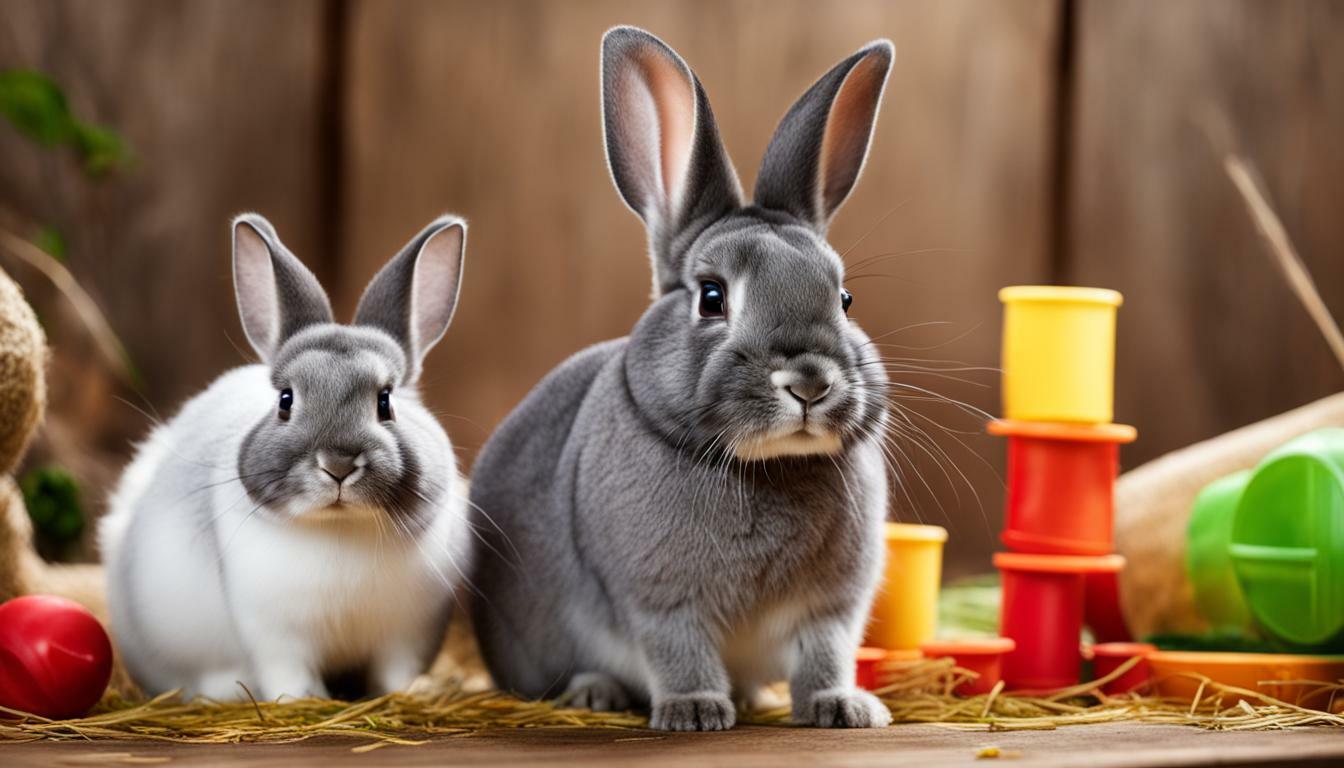Many pet owners wonder if it’s possible for rabbits and chinchillas to live together harmoniously. While these two adorable creatures may seem like they could make great companions, it’s important to consider their individual needs and behaviors before attempting to house them together.
Key Takeaways:
- Rabbits and chinchillas have different dietary, housing, and grooming needs.
- Chinchillas require regular dust baths, which can cause respiratory problems for rabbits.
- Rabbit droppings contain bacteria that can be harmful to chinchillas.
- Chinchillas may be aggressive towards other animals, including rabbits.
- Rabbits and chinchillas have different play styles and handle heat differently.
Dietary and Housing Differences
Rabbits and chinchillas have different dietary and housing needs, which makes cohabitation difficult. Rabbits are herbivores and require a diet rich in hay, fresh vegetables, and limited pellets. On the other hand, chinchillas are strict herbivores and should consume a specialized diet of hay, chinchilla pellets, and occasionally treats. These dietary differences can lead to imbalances and health issues if they are housed together and share the same food.
In terms of housing, rabbits and chinchillas also have distinct requirements. Rabbits are larger and need ample space to exercise and hop around. They benefit from having a hutch or a large cage with enough room for them to explore. Chinchillas, on the other hand, are smaller and more active during the night. They require a spacious, multi-level cage with platforms, hiding spots, and a solid floor to prevent foot injuries.
Attempting to house rabbits and chinchillas together in the same cage can result in stress, territorial conflicts, and aggression. This can be detrimental to the well-being and health of both animals. It is important to provide separate living spaces that cater to their specific needs and allow them to thrive.
| Rabbits | Chinchillas |
|---|---|
| Herbivores | Strict herbivores |
| Diet includes hay, vegetables, and limited pellets | Diet includes hay, chinchilla pellets, and occasional treats |
| Require a hutch or a large cage with ample space for exercise | Require a spacious, multi-level cage with platforms and hiding spots |
Grooming Requirements
Proper grooming is essential for both rabbits and chinchillas, but their requirements differ significantly. Rabbits are meticulous self-groomers, using their tongues and paws to keep their fur clean and free of tangles. Regular brushing is recommended to remove loose fur and prevent hairballs. On the other hand, chinchillas have dense fur that requires frequent dust baths to remove excess oil and maintain their coat’s health. These dust baths are essential for chinchillas’ well-being but may pose a risk to rabbits, as the fine dust particles can irritate their respiratory system.
Different Grooming Techniques
Rabbits and chinchillas have different grooming techniques, and it’s important to consider this when integrating them. While rabbits groom themselves, chinchillas rely on their owners to provide dust baths in specialized containers. These dust baths typically contain special chinchilla dust or fine volcanic ash. It’s crucial to have separate grooming areas and ensure that rabbits do not come into contact with the chinchilla dust, as it can lead to respiratory issues.
In addition to dust baths, chinchillas may require regular nail trims and dental care, as their teeth continuously grow. Dental health is vital for chinchillas, as overgrown teeth can cause pain and difficulty eating. Rabbits, on the other hand, have self-wearing teeth and typically do not require dental intervention unless there are underlying dental issues.
When grooming both rabbits and chinchillas, it’s essential to use appropriate tools and handle them gently to prevent stress or injury. Soft-bristle brushes are suitable for rabbits, while chinchillas may require special combs or brushes designed for their dense fur. Regular grooming sessions can help strengthen the bond between owners and their furry companions and ensure their overall health and well-being.
| Grooming Requirements | Rabbits | Chinchillas |
|---|---|---|
| Brushing | Regular brushing to remove loose fur | Dust baths to remove excess oil |
| Nail Trims | Occasional nail trims | Regular nail trims |
| Dental Care | Minimal dental intervention | Potential for dental issues and regular dental care |
Dust Baths and Respiratory Issues
Chinchillas require regular dust baths, which can pose respiratory risks for rabbits when living in close proximity. The nature of chinchillas’ fur and skin requires them to roll in fine dust to maintain their health and hygiene. However, this dust can cause respiratory problems for rabbits, who have sensitive respiratory systems.
When rabbits and chinchillas are housed together, the dust from the chinchilla’s bath can become airborne, leading to respiratory discomfort and potential health issues for the rabbits. The particles in the dust can irritate the rabbits’ respiratory tracts and may even cause respiratory infections.
It is essential to keep in mind that while rabbits and chinchillas can coexist in the same house, it is crucial to provide separate living spaces for them. This ensures that the rabbits are not exposed to the chinchillas’ dust baths, reducing the risk of respiratory issues.
| Rabbits | Chinchillas |
|---|---|
| Require clean, dry living environment | Need regular dust baths |
| Sensitive respiratory systems | Resistant to respiratory issues caused by dust |
| Produce droppings that contain bacteria | Can be harmed by bacteria in rabbit droppings |
“The particles in the dust can irritate the rabbits’ respiratory tracts and may even cause respiratory infections.”
- Place your rabbit’s living area in a separate space from the chinchilla’s living area to prevent exposure to dust.
- Ensure proper ventilation in both areas to reduce the concentration of airborne particles.
- Regularly clean and replace the bedding in the rabbit’s living area to maintain a clean environment.
By providing separate spaces for rabbits and chinchillas with proper ventilation and hygiene practices, you can minimize the risk of respiratory issues for your rabbits and promote their overall well-being.
Bacteria in Droppings
Rabbit droppings contain bacteria that can be harmful to chinchillas if they share the same living space. Chinchillas are susceptible to certain bacteria present in rabbit feces, such as Clostridium difficile and Campylobacter, which can lead to gastrointestinal issues and other health problems. It is essential to keep their living areas separate to prevent the transmission of these bacteria.
Chinchillas are delicate creatures with sensitive digestive systems, and their immune systems may not be equipped to handle the bacteria found in rabbit droppings. Introducing chinchillas to an environment contaminated with rabbit feces increases the risk of infection and can have severe consequences for their health. It is crucial to prioritize their well-being by ensuring they have their own living space.
| Bacteria Found in Rabbit Droppings | Effects on Chinchillas |
|---|---|
| Clostridium difficile | Can cause gastrointestinal issues and diarrhea in chinchillas. |
| Campylobacter | May lead to digestive problems and general illness in chinchillas. |
To ensure the health and safety of both your rabbits and chinchillas, it is best to provide them with separate cages and living areas. This will minimize the risk of exposure to harmful bacteria and allow each species to thrive in an environment tailored to their specific needs. By maintaining proper hygiene and cleanliness, you can reduce the chances of cross-contamination and promote the overall well-being of your pets.
Aggression and Incompatibility
Chinchillas have a tendency to be aggressive towards other animals, including rabbits, which can lead to compatibility issues. It is important to consider this behavior when deciding to house them together. Rabbits are known to have a strong kick that can be lethal to chinchillas, making it risky to keep them in the same cage.
In addition to aggression, rabbits and chinchillas have different play styles. Rabbits are more active and playful, while chinchillas prefer to be in a quieter environment. This difference can cause further conflicts between the two species and make it challenging for them to coexist peacefully.
Furthermore, rabbits and chinchillas handle heat differently. Rabbits are more tolerant of warm temperatures, while chinchillas are more sensitive and prone to heat stress. Housing them together may not provide the ideal environment for both species to thrive.
| Rabbits | Chinchillas |
|---|---|
| Active and playful | Prefer a quieter environment |
| More tolerant of warm temperatures | Prone to heat stress |
Overall, while it is possible for rabbits and chinchillas to become friends with careful introduction and supervision, it is generally recommended to house them separately to ensure their individual needs are met and to prevent any potential conflicts or health issues that may arise. They can live in the same house, but it is crucial to provide separate living spaces to ensure the well-being of both species.
Play Styles and Heat Sensitivity
Rabbits and chinchillas have different play styles and react differently to heat, which can impact their ability to coexist peacefully. Understanding these differences is crucial when socializing these two species.
Play Styles: Rabbits are known for their energetic and often boisterous play, hopping around, and binkying. On the other hand, chinchillas have a more cautious and agile play style. They enjoy jumping, climbing, and exploring their surroundings. This difference in play styles can lead to misunderstandings and potential aggression between the two species.
Heat Sensitivity: Rabbits are more heat-sensitive than chinchillas. They can easily become overheated, especially in hot climates or when exposed to direct sunlight. Chinchillas, on the other hand, have a higher tolerance for heat and prefer cooler temperatures. This difference in heat sensitivity can cause stress and discomfort for rabbits when trying to socialize with chinchillas in warmer environments.
To ensure the well-being and safety of both rabbits and chinchillas, it is essential to provide separate spaces where they can engage in their individual play styles and regulate their body temperature. This can be achieved by setting up separate play areas or cages tailored to each species’ needs.
The Difference in Play Styles
The play styles of rabbits and chinchillas can be quite distinct. Rabbits are highly social animals and often enjoy the company of humans and other rabbits. They engage in playful activities such as running, jumping, and tossing toys. On the other hand, chinchillas have a more independent nature and tend to prefer solitary play or play with their own kind. They are agile jumpers and climbers, making them excellent at exploring their environment.
Rabbit Play Behaviors:
- Hopping and binkying
- Chewing and tossing toys
- Running and racing
Chinchilla Play Behaviors:
- Jumping and climbing
- Exploring and investigating
- Playing with tunnel toys
Understanding these play styles can help you create separate play areas or enriching environments that cater to the specific needs of each species. This will ensure they can engage in their natural behaviors without the risk of conflicts or stress.
| Rabbits | Chinchillas |
|---|---|
| Highly social | More independent |
| Love running and jumping | Skilled climbers |
| Enjoy playing with toys | Prefer exploration |
Introducing and Supervising
Introducing rabbits and chinchillas requires careful planning and constant supervision to ensure their safety and well-being. These furry friends have unique needs and behaviors that must be taken into consideration when attempting to coexist. Here are some important tips for successfully introducing and supervising rabbits and chinchillas:
- Separate living spaces: Rabbits and chinchillas should never be housed together in the same cage. They have different dietary and housing requirements, and sharing a cage can lead to stress and health problems. Provide each animal with their own separate enclosure to ensure they have enough space to explore and feel secure.
- Gradual introductions: When introducing rabbits and chinchillas, it is best to start with short supervised visits in a neutral area. Use a playpen or large, open space where both animals can interact without feeling threatened. Monitor their behavior closely to ensure there are no signs of aggression or distress.
- Supervision is key: Never leave rabbits and chinchillas unsupervised, especially during the initial stages of their interaction. Even if they seem to be getting along, it’s important to observe their behavior and prevent any potential conflicts or accidents. Remember, rabbits have a strong kick that can be lethal to chinchillas, so constant supervision is essential.
While it is possible for rabbits and chinchillas to develop a friendship with patient introduction and supervision, there is no guarantee that they will get along. Some rabbits and chinchillas may never be compatible due to their individual personalities and instincts. It’s important to be prepared for this possibility and have a backup plan in case they cannot coexist peacefully.
| Summary of Tips |
|---|
| Separate living spaces |
| Gradual introductions |
| Supervision is key |
Potential for Friendship
While it is possible for rabbits and chinchillas to coexist and potentially become friends, it requires patience, supervision, and acceptance of the possibility that they may not form a bond. Rabbits and chinchillas have different needs and behaviors, which can make it challenging for them to live together harmoniously. However, with proper introduction and ongoing evaluation, there is a chance that they can develop a positive relationship.
When introducing rabbits and chinchillas, it is important to start with separate living spaces. This allows them to become familiar with each other’s scent and presence before any direct interaction occurs. Gradually, under close supervision, you can begin to introduce them in neutral territory, such as a playpen or a large enclosed area. Keep in mind that it may take several weeks or even months for them to become comfortable with each other.
During the introduction process, it is crucial to monitor their behavior closely. Look for signs of aggression, such as lunging, biting, or fur pulling. If any aggressive behavior is observed, it is best to separate them and reassess the situation. Some rabbits and chinchillas may simply not be compatible as roommates, and it is essential to prioritize their safety and well-being.
| Rabbits | Chinchillas |
|---|---|
| Rabbits have a strong kick and powerful hind legs, which can be lethal to chinchillas if they feel threatened. | Chinchillas may display aggression towards other animals, including rabbits, as they are naturally territorial. |
| Rabbits have a different play style, often involving hopping and running. | Chinchillas have a unique play style, which includes leaping and agility. |
| Rabbits are more heat-tolerant and can withstand higher temperatures. | Chinchillas are more sensitive to heat and can easily overheat, which can be life-threatening. |
In conclusion, while it is possible for rabbits and chinchillas to become friends, it is important to consider their individual needs and behaviors. Proper introduction, supervision, and ongoing evaluation are crucial in determining whether they can live together. Remember to prioritize their well-being and be prepared for the possibility that they may never form a bond. When in doubt, consult with a veterinarian or an experienced animal behaviorist for guidance.
Conclusion
In conclusion, rabbits and chinchillas have different needs and behaviors that make it challenging to house them together, but with careful introduction and ongoing supervision, they can potentially coexist peacefully.
Rabbits and chinchillas should not be housed in the same cage due to their dietary, housing, and grooming differences. Chinchillas require regular dust baths to maintain their fur, which can lead to respiratory issues for rabbits. Additionally, rabbit droppings contain bacteria that can be harmful to chinchillas, making it imperative to keep their living spaces separate.
It is important to note that rabbits have a strong kick that can be lethal to chinchillas, and chinchillas may exhibit aggression towards other animals, including rabbits. Furthermore, rabbits and chinchillas have different play styles and heat sensitivities, which should be taken into consideration when attempting to socialize them.
While it is possible for rabbits and chinchillas to become friends with careful introduction and ongoing supervision, it is crucial to always monitor their behavior and interactions. It is essential to create a safe and controlled environment where both pets can coexist without causing harm or stress to each other.
FAQ
Can rabbits and chinchillas live together?
No, rabbits and chinchillas should not be housed together in the same cage.
What are the dietary and housing differences between rabbits and chinchillas?
Rabbits and chinchillas have different dietary and housing needs, making it challenging to house them together.
What are the grooming requirements for rabbits and chinchillas?
Rabbits and chinchillas have different grooming needs, which can be difficult to meet when living together.
Can chinchillas’ dust baths cause respiratory problems for rabbits?
Yes, regular dust baths for chinchillas can be harmful to rabbits’ respiratory health.
Are rabbit droppings harmful to chinchillas?
Yes, rabbit droppings contain bacteria that can be harmful to chinchillas.
Are chinchillas aggressive towards rabbits and other animals?
Yes, chinchillas may exhibit aggression towards other animals, including rabbits.
How do rabbits and chinchillas differ in play styles and heat sensitivity?
Rabbits and chinchillas have different play styles and handle heat differently.
How should rabbits and chinchillas be introduced and supervised?
Rabbits and chinchillas should be carefully introduced and supervised when attempting to coexist.
Is it possible for rabbits and chinchillas to become friends?
With careful introduction and supervision, rabbits and chinchillas can potentially become friends.
Can rabbits and chinchillas be left alone together?
No, rabbits and chinchillas should not be left alone together even if they become friends.




